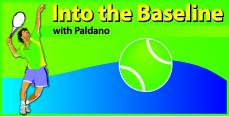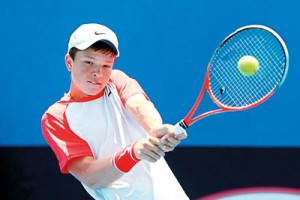‘Orange-Bowl’ of Florida fame
Elevating the status of the junior player and their ranking tradition began with the Orange-Bowl event in Florida, USA in 1947. In fact, it is this event that made Florida known for its Tennis. Like computers making the silicon-valley, Florida in a way, was made by Tennis. Today the Orange-Bowl is the most prestigious junior event.
It has a grade ‘A’ status in the ITF world junior ranking and it is one of five of its kind in the annual calendar. The other four are the Grand-Slam junior titles. Orange-Bowl has an unbroken record since 1947. Winning the Orange-Bowl marks the player as a future potential and it has proved it to be that way for a good while. Most of the Orange-bowl winners ended up being ‘mega names.’
 The origin
The origin
It was started by Eddie Herr. He wanted to take the game south of USA for his daughter Suzanne to play in the winter of 1947. Flamingo Park was the original venue of the event. Since then, it has gone to more glamorous places and this year’s event was in Plantation, Florida. This was the event’s 66th year and was staged on clay courts for the first time since 1988. Martina Navratilova was given a special honour at this event.
Originally only the US players were permitted to participate and over the years it was open to twenty nations. Today, it is global participation. The emphasis was on ‘youth’ originally and had under 17 and 18 competitions. The main event is still the under 18 and recent times under 16, 14 and 12 are added as ‘Junior Orange-Bowl’. The idea of using this system is to development platform caught on in the USA. Many sports used and still use the Orange-Bowl competition as the propelling platform to develop their sport.
The list of Orange-Bowl winners are good as the ‘who is who’ in Tennis. The winners list has the most elegant stroke maker Arthur Ash and then on, it is filled with every big name that won grand slams. Miami’s Mary Joe Fernandez has the record of winning every age group title. The boys list include Switzerland’s Roger Federer as the winner of 1998.
Sport education and maturity
Almost every nation followed the Orange-Bowl trend and came up with a strong junior event to promote Tennis. Early sports education is meant for participation and not for perfection or to mark achievements.
In early years, the purpose of sport is to advance in skills and to make that the goal. This would emphasize the path to play a good game when the physical and mental capacity maturity peaks. Unfortunately in many countries this is not the approach. Too much of junior competition negates the advantage junior Tennis has on development. At about the age of 15, if a player does not enter open-Tennis but stay only with junior involvement, the pursuit will be a wasted venture. It is for this reason that the professional circuit permits 15 year olds to play in their events.
Maturity factor often comes into discussion in junior Tennis. Tennis being an open-sport, the challenge is not a constant. In such a situation, being able to face and overcome variables is the maturity factor. The reason for closed age group events is to limit the open-sport challenge at early stages of development to focus on skills. That is not addressing technical perfection but technical adaptation to suit the individuals and get used to the climate of competition.
What did the Orange-Bowl do?
Up to the fifties, junior events never stood alone but only as a part of the main open events. It is the Orange-Bowl that made a junior event to stand on its own. Even now, very few venues succeed doing this. When the Orange-Bowl was played on Clay courts, many good Americans came to being. The switch to hard courts deprived US juniors developing their all court ability.
Going back to clay courts this year could be a strategy to bring US players into the limelight in the future. The new age Tennis requires players to be versatile and posses all court abilities. Hard courts with its high bounce, forces youngsters into eye level ball contact which is only comfortable with the extreme western grip. Unfortunately this grip does not permit comfortable all-court play. Orange-Bowl as an event always played a part in leading the development path by the choice of surface. It is doing so now again.
This year’s Orange-Bowl concluded on the 14th of December. Two US players won the main events for the Stefan Kozlov and the under 18 girl’s title went to Sofia Kennis first time since 2004. The boy’s title was won by Cici Bellis of USA on the way up to the finals. Fifteen-year-old Bellis made news when she made into the third round in the 2014 US-Open in New-York. Bellis has a good junior 2014 record and her loss to Kozlov in Orange-Bowl did not stop her being the world’s number one player this year. Boy’s junior number one is Russia’s Andery Rublev.

Stefan Kozlov
Contribution to Tennis and community
Florida has a strong Tennis community for many a reason. Two of the salient once are Orange-Bowl and its warm weather. These are the secret behind esteemed Florida’s identity in the global Tennis world.
Existence of a Tennis community means playing facilities come to being. This caters the need of competition players, recreational players, player development and tennis institutions. All of these have created a strong economic and social mix acting to boost sports and events. Orange-Bowl as an event gets many thousand visitors into Florida in the first two weeks of December. It is a boost to Florida in every aspect of its popularity. The global tennis today stands on few very well established pillars. Florida’s Orange-Bowl is certainly is one of them.
-George Paldano, former international player; Accredited Coach of Germany; National coach; Davis Cup and Federation Cup Coach; ITF and USPTR– gptennis.ceylon@gmail.com-


